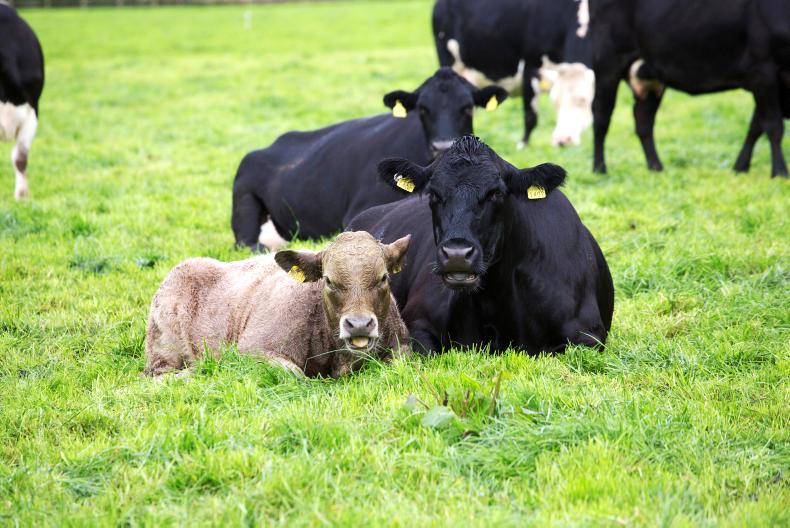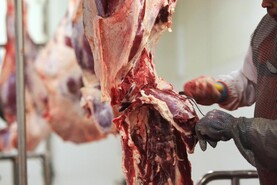Newford Farm was established by Dawn Meats and Teagasc. The 100-cow suckler-to-beef demonstration herd commenced operations in Newford, Athenry, Co Galway, in 2015 on 55.8ha of land previously farmed by Teagasc.
The link-up between the two organisations sees Dawn Meats employ the farm manager and cover all costs of employment, while also funding capital costs to establish the farm (livestock and capital investment).
Teagasc provides the land, including funding land rental costs, and delivers technical advice for the project, which is set to run until 2022.
Farm manager Matthew Murphy is the man charged with the day-to-day running of the herd and has been working with the herd from the outset in Athenry.
Objectives
There are a number of objectives in the project that is driven by Dawn Meats, Teagasc and the Irish Farmers Journal, and also has backing from McDonald's.
The management team is made up of the farm manager and members from Teagasc, Dawn Meats and the Irish Farmers Journal, while the stakeholder team also has farmer representation.
The overriding aim is to generate a high profit from a grass-based, suckler-to-steer and heifer-beef production system.
There is also a focus on quantifying the labour required to operate a 100-cow unit, while also developing benchmarks and production targets for a herd by utilising a breeding policy and cow type that differs from the majority of Irish suckler enterprises.
Overview
An overview of the farm plan is detailed in Table 1. The aim is to grow profitability each year, with a target gross margin of €1,170/ha and a net margin in the region of €520/ha achieved by 2019/2020.
The farm’s financial performance takes account of casual labour, but does not include the full-time labour unit or any land rental costs, with the aim of the project to deliver a net return in excess of €29,000 to support a full-time labour unit.
There are no direct payments (Basic Payment Scheme or Areas of Natural Constraint), with the exception of the Beef Data and Genomics Programme payment of €8,500.
Costs in check
The foundation of the farm plan is achieving high levels of output while keeping variable costs in check.
As Table 1 shows, the farm has failed to achieve financial performance targets to date, contending with higher variable costs than planned, some of which has stemmed from continual weather challenges.
The farm has achieved positive levels of output, but this has come at a higher than planned cost, with the finishing blueprint based on finishing 70% to 80% of cattle off grass.
System adjustments
The farm has had to deal with disruption to the farm plan in terms of the land area available altering.
The farm lost 8ha (20 acres) of the Raheen Woods land block totalling 15.51ha (38 acres) at the start of 2017.
Teagasc sourced the Tuohy’s land block of 12.95ha (32 acres) and this was included into the project in 2017.
The land type is heavier than the Raheen Woods land block, which was utilised for an early grazing in spring, two cuts of silage and a late grazing in autumn. The additional acres also facilitated the number of cows calving to be kept at 110 cows, ensuring a high stocking rate is maintained.
The project lost the remainder of the Raheen Woods land block in 2018, which put additional pressure on the system in spring and added to the delayed turnout. It was also the underlying reason why the sale of 2017-born heifers was considered in early 2018 and enacted upon when drought hit.
The farm purchased silage from a 16ha land block in 2018 and is currently working on securing land to bring the stocking rate and system back into balance for a herd grazing 100-plus cows and their progeny.
System overview
Watch the interview with Padraig French below.
Newford Farm was established by Dawn Meats and Teagasc. The 100-cow suckler-to-beef demonstration herd commenced operations in Newford, Athenry, Co Galway, in 2015 on 55.8ha of land previously farmed by Teagasc.
The link-up between the two organisations sees Dawn Meats employ the farm manager and cover all costs of employment, while also funding capital costs to establish the farm (livestock and capital investment).
Teagasc provides the land, including funding land rental costs, and delivers technical advice for the project, which is set to run until 2022.
Farm manager Matthew Murphy is the man charged with the day-to-day running of the herd and has been working with the herd from the outset in Athenry.
Objectives
There are a number of objectives in the project that is driven by Dawn Meats, Teagasc and the Irish Farmers Journal, and also has backing from McDonald's.
The management team is made up of the farm manager and members from Teagasc, Dawn Meats and the Irish Farmers Journal, while the stakeholder team also has farmer representation.
The overriding aim is to generate a high profit from a grass-based, suckler-to-steer and heifer-beef production system.
There is also a focus on quantifying the labour required to operate a 100-cow unit, while also developing benchmarks and production targets for a herd by utilising a breeding policy and cow type that differs from the majority of Irish suckler enterprises.
Overview
An overview of the farm plan is detailed in Table 1. The aim is to grow profitability each year, with a target gross margin of €1,170/ha and a net margin in the region of €520/ha achieved by 2019/2020.
The farm’s financial performance takes account of casual labour, but does not include the full-time labour unit or any land rental costs, with the aim of the project to deliver a net return in excess of €29,000 to support a full-time labour unit.
There are no direct payments (Basic Payment Scheme or Areas of Natural Constraint), with the exception of the Beef Data and Genomics Programme payment of €8,500.
Costs in check
The foundation of the farm plan is achieving high levels of output while keeping variable costs in check.
As Table 1 shows, the farm has failed to achieve financial performance targets to date, contending with higher variable costs than planned, some of which has stemmed from continual weather challenges.
The farm has achieved positive levels of output, but this has come at a higher than planned cost, with the finishing blueprint based on finishing 70% to 80% of cattle off grass.
System adjustments
The farm has had to deal with disruption to the farm plan in terms of the land area available altering.
The farm lost 8ha (20 acres) of the Raheen Woods land block totalling 15.51ha (38 acres) at the start of 2017.
Teagasc sourced the Tuohy’s land block of 12.95ha (32 acres) and this was included into the project in 2017.
The land type is heavier than the Raheen Woods land block, which was utilised for an early grazing in spring, two cuts of silage and a late grazing in autumn. The additional acres also facilitated the number of cows calving to be kept at 110 cows, ensuring a high stocking rate is maintained.
The project lost the remainder of the Raheen Woods land block in 2018, which put additional pressure on the system in spring and added to the delayed turnout. It was also the underlying reason why the sale of 2017-born heifers was considered in early 2018 and enacted upon when drought hit.
The farm purchased silage from a 16ha land block in 2018 and is currently working on securing land to bring the stocking rate and system back into balance for a herd grazing 100-plus cows and their progeny.
System overview
Watch the interview with Padraig French below.






 This is a subscriber-only article
This is a subscriber-only article










SHARING OPTIONS: